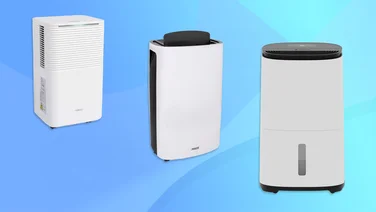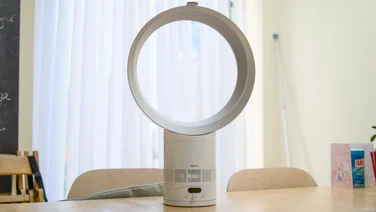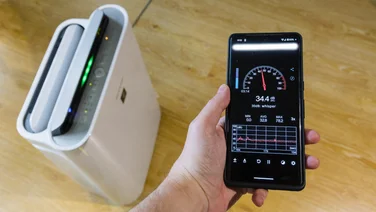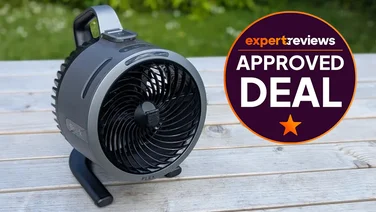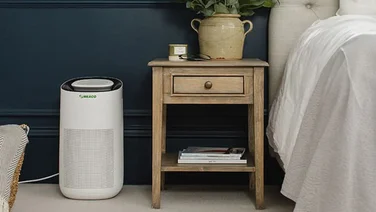To help us provide you with free impartial advice, we may earn a commission if you buy through links on our site. Learn more

Are you concerned about the air you breathe in your home? Well if so, you may have looked at air purifiers, which claim to clean up the air in your house, with the implied suggestion that there are health benefits in doing so. De’Longhi, a brand we more associate with creating nice smells such as coffee and toast, than banishing bad ones, lent us its top-of-the-range model to test, the AC230 Air Purifier.
The AC230 is pretty attractive as plastic boxes go, it’s white with a silver front panel, and will be largely inconspicuous in a modern house. It’s not very loud either, or at least its not loud at its low fan setting. The controls are touch sensitive buttons on top, and though there’s quite a few, and quite a few features, it’s pretty much just a matter of turning it on or off really, but more on that later.
FAMOUS FIVE
The AC230 has five different air filtering methods, some of which have a good scientific basis and some of which are a little more debatable in their usefulness. Although by throwing them all in here you’re certainly hedging your bets against any airborne nasties.
First up is a basic dust filter just to stop the big stuff stuffing up the other filters. Then comes the HEPA filter, which is arguably the most important, it’s the same kind of filter you find in vacuum cleaners intended for use in pet-owning homes, and is capable of filtering out all but the tiniest of particles including most allergens, airborne viruses and the like.
However the problem is that many such particles don’t reach the filter, as they stick to surfaces and are only unleashed into the air when disturbed, as the American Environmental Protection Agency (EPA) states filters are: “Ineffective in removing larger particles because most settle from the air quickly and never reach filters.”
In short, most of the airborne particles in your home occur when you disturb them and you then breathe them in as they go airborne right next to you, and a filter on the other side of the room isn’t going to help much. Running one in a room while you’re dusting or vacuuming isn’t a bad idea though, as a second line of defence. For more on removing allergens from your home read our recent article about Dust Busting: Dyson talks allergies and how to keep them out of your home.
HEPA will not filter out smells, as these are far smaller particles still, so a second carbon filter is attached to the rear of the HEPA one to help trap these. This is certainly effective and rooms we used the AC230 smelled fresher while it was running.
Beyond this is a silver filter and UV light filter, both of which are designed to kill off anything that gets through the HEPA filter. As far as we understand it, these seem a little overkill, as nothing is likely to make it through the HEPA filter anyway. There have been a number of cases worldwide where advertisers have been sanctioned for making grand claims about this kind type of filter, De’Longhi simply says that it’s ‘effective against bacteria’.
The UV filter is also supposed to kill off biological threats to your health, but the EPA simply states that: “There are no studies to date linking … UVGI and PCO systems
[the common UV methods for air filtration]
in homes to reduced health symptoms in sensitive populations.”
There’s also an ionizer which you can switch on and off independently of other functions. These have lost their associations with generating potentially hazardous ozone levels, but there’s still no solid evidence to show that there’s a health benefit from using one.
AIR TRAFFIC CONTROL
All the physical filters are accessible from the front, so you can easily pop them out and vacuum them, or dust them off, outside preferably in order to keep everything ticking along, though an indicator will remind you to replace the main filter every 720 hours at a cost of around £25 for a new one.
At the top of the device are the controls. There are three fan speeds and a timer so you can run the AC230 for 1, 2, 4 or 8 hours. An auto fan control is supposed to up the fan speed when pollutants are detected, though we never managed to provoke it into effect, despite trying burning toast, steam and a whole room full of men playing video games for five hours with the door shut.
The AC230 has an Air Quality System, which is supposed to monitor air quality and inform you of changes. It takes the form of orange, green and blue lights, which represent ‘poor’, ‘satisfactory’ and ‘good’ air quality. We found that no matter the situation the AC230 would report ‘poor’ air quality for the roughly the first three minutes after being turned on and then flick to ‘good’. It did this even if we turned it off on ‘good’ and immediately back on again, when it would flick back to ‘poor’ again for three minutes.
Even giving it the benefit of the doubt and allowing that it takes three minutes for it to test the air properly, we’re surprised that it cleaned the air to ‘good’ in three minutes. We tested it in our kitchen, just after cooking, with no extractor on and the windows and doors shut and it still behaved the same way. Running the fan at low or high speeds seemed to make no difference to the 3 minutes and it’s ‘good’ rule.
BREATHING EASIER?
Air Purifiers are tricky things to review. We have absolutely no doubt that this is a well engineered example that does its absolute best to remove particles floating around in the air in your home. However, the real discussion is how useful that really is.
If you’re dead set on getting an air purifier, in order to do absolutely everything you can to combat allergens in your home then the AC230 will fit the bill, though we’d do some lengthy research before using the ioniser.
In short, regular dusting, hoovering with a HEPA filter vacuum cleaner and washing sheets, are your main weapons against airborne particles in your home, and an air purifier should be thought of as a possible extra precaution, not a key element. At £290 the AC230 is at the top of price range, but if you have problems with allergies then we can understand that this may not seem like an excessive price to pay, even if the benefits may only be minimal.


